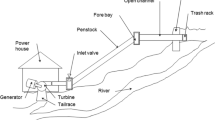Abstract
Purpose of Review
Hydroelectric generation is a potential flexible electricity source that can ease the transition to a decarbonized energy economy. As such, using scarce hydroelectric generating resources efficiently is important. We examine approaches to represent the operating characteristics of hydroelectric resources.
Recent Findings
Many hydroelectric-plant owners use water tables or generic unit characteristics for operational planning. Such practice may be inefficient, as it does not account for unit-specific operating-characteristic changes or time-related impacts, e.g., plant degradation. We demonstrate a data-driven approach to modeling plant operations that is unit-specific and depends solely on observable and controllable variables.
Summary
Numerical results using historical data for four hydroelectric units illustrate the proposed methodology.





Similar content being viewed by others
References
Papers of particular interest, published recently, have been highlighted as: • Of importance •• Of major importance
Burrow A, Newman AM, Bazilian M. Reservoir design and operation for the food-energy-water Nexus. Current Sustainable/Renewable Energy Reports 2019;6:71–89.
Avraam C, Zhang Y, Sankaranarayanan S, Zaitchik B, Moynihan E, Juturu P, Neff R, Siddiqui S. Optimization-based systems modeling for the food-energy-water nexus. Current Sustainable/Renewable Energy Reports 2021;8:4–16.
García-Morales MB, Dubus L. Forecasting precipitation for hydroelectric power management: how to exploit GCM’s seasonal ensemble forecasts. Int J Climatol 2007;27:1691–1705.
Boucher M-A, Ramos MH. Ensemble streamflow forecasts for hydropower systems. Handbook of hydrometeorological ensemble forecasting. In: Duan Q, Pappenberger F, Wood A, Cloke HL, and Schaake JC, editors. Berlin: Springer; 2019. p. 1289–1306.
Singh VK, Singal SK. Operation of hydro power plants-a review. Renew Sustain Energy Rev 2017;69:610–619.
Gfrerer H. Optimization of hydro energy storage plant problems by variational methods. Zeitschrift für Oper Res 1984;28:B87–B101.
Bauer W, Gfrerer H, Wacker H. Optimization strategies for hydro energy storage plants. Zeitschrift für Oper Res 1984;28:B103–B131.
Catalão J, Mariano SJPS, Mendes VMF, Ferreira LAFM. Scheduling of head-sensitive cascaded hydro systems: a nonlinear approach. IEEE Trans Power Syst 2009;24:337–346.
Pousinho HMI, Contreras J, Catalão JPS. Short-term optimal scheduling of a price-maker hydro producer in a pool-based day-ahead market. IET Generation, Transmission & Distribution 2012;6:1243–1251.
Philpott AB, Craddock M, Waterer H. Hydro-electric unit commitment subject to uncertain demand. Eur J Oper Res 2000;125:410–424.
Pérez-Díaz JI, Chazarra M, García-González J, Cavazzini G, Stoppato A. Trends and challenges in the operation of pumped-storage hydropower plants. Renew Sustain Energy Rev 2015;44: 767–784.
Séguin S., Fleten S-E, Côté P., Pichler A, Audet C. Stochastic short-term hydropower planning with inflow scenario trees. Eur J Oper Res 2017;259:1156–1168.
Marchand A, Gendreau M, Blais M, Guidi J. Optimized operating rules for short-term hydropower planning in a stochastic environment. Comput Manag Sci 2019;16:501–519.
• Taktak R, D’Ambrosio C. An overview on mathematical programming approaches for the deterministic unit commitment problem in hydro valleys. Energy Systems 2017;8:57–79. Considers various assumptions that are used for simplifications of unit-commitment models with hydroelectric generators, including linearizations of penstock loss.
Piekutowski MR, Litwinowicz T, Frowd RJ. Optimal short-term scheduling for a large-scale cascaded hydro system. IEEE Trans Power Syst 1994;9:805–811.
Blom E, Söder L, Risberg D. Performance of multi-scenario equivalent hydropower models. Electr Power Syst Res 2020;187:106486.
Shawwash ZK, Siu TK, Russell SOD. The B.C. hydro short term hydro scheduling optimization model. IEEE Trans on Power Syst 2000;15:1125–1131.
Rajšl I, Ilak P, Delimar M, Krajcar S. Dispatch method for independently owned hydropower plants in the same river flow. Energies 2012;5:3674–3690.
Ikura Y, Gross G. Efficient large-scale hydro system scheduling with forced spill conditions. IEEE Trans Power Appar Syst 1984;PAS-103:3502–3520.
Diniz AL, Esteves PPI, Sagastizábal CA. A mathematical model for the efficiency curves of hydroelectric units. 2007 IEEE Power Engineering Society General Meeting, Tampa, Florida; 2007. Institute of Electrical and Electronics Engineers.
•• Hidalgo IG, Fontane DG, Lopes JEG, Andrade JGP, de Angelis AF. Efficiency curves for hydroelectric generating units. J Water Resour Plan Manag 2014;140:86–91. Uses historical measured power, head level, and water flow to fit efficiency curves for hydroelectric generating units to determine performance characteristics.
Kong J, Skjelbred HI, Abgottspon H. Short-term hydro scheduling of a variable speed pumped storage hydropower plant considering head loss in a shared penstock. IOP Conference Series: Earth and Environmental Science 2019;240:082002.
Breton M, Hachem S, Hammadia A. Accounting for losses in the optimization of production of hydroplants. IEEE Trans Energy Convers 2004;19:346–351.
Streeter VL, Wylie EB. Fluid mechanics, seventh edition. New York: The McGraw-Hill Companies, Inc.; 1979.
Ruud PA. 2000. An introduction to classical econometric theory: Oxford University Press, New York.
Acknowledgements
The authors thank the editors, reviewer, and Armin Sorooshian (University of Arizona) for helpful comments and discussions and staff of American Electric Power Company, Inc. for providing historical hydroelectric-unit operational data. Any opinions and conclusions that are expressed in this paper are solely those of the authors.
Funding
This work was supported by National Science Foundation grant 1808169.
Author information
Authors and Affiliations
Corresponding author
Ethics declarations
Human and Animal Rights and Informed Consent
This article does not contain any studies with human or animal subjects performed by any of the authors.
Conflict of Interests
The authors declare no competing interests.
Additional information
Publisher’s Note
Springer Nature remains neutral with regard to jurisdictional claims in published maps and institutional affiliations.
This article is part of the Topical Collection on Energy Market
Rights and permissions
About this article
Cite this article
Hunter-Rinderle, R., Sioshansi, R. Data-Driven Modeling of Operating Characteristics of Hydroelectric Generating Units. Curr Sustainable Renewable Energy Rep 8, 199–206 (2021). https://doi.org/10.1007/s40518-021-00197-1
Accepted:
Published:
Issue Date:
DOI: https://doi.org/10.1007/s40518-021-00197-1




